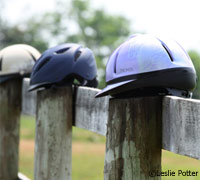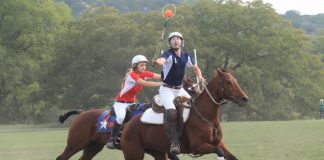 Here are some facts and myths that every rider needs to know about protective headwear.
Here are some facts and myths that every rider needs to know about protective headwear.
Facts
- Horseback riders have the same number of injury accidents* as motorcycle riders.Because the hospital admission rate for injured riders (0.49/1000 hours) is greater than motorcycle riding (0.14/1000 hours), football and skiing, it is definitely considered a high-risk activity, per a study cited in The Equestrian Medical Safety Association (EMSA) Spring 2010 Newsletter.
- Your horse doing something unpredictable—like spooking, bucking, or bolting—is how most head injuries occur, but 20% happen when you’re simply around horses.
The majority of head injuries are caused by unpredictable events, such as your horse spooking. And even more surprising, 1 in 5 people who are seriously injured weren’t even riding – they were just hanging out around horses or watching someone else. - The most common reason among riders for admission to hospital and death are head injuries.
About 70,000 people go to the emergency room each year for equestrian-related injuries. About 12,000 of those people have suffered head injuries. - Helmets work. Most deaths from head injury can be prevented by wearing ASTM/SEI approved helmets that fit correctly and have the harness firmly applied.
To get the most protection out of your helmet, it needs to fit you well, and be properly adjusted every single time you ride, including a snug chin strap. - Most riding injuries occur during pleasure riding.
Myths
- Bike or skateboard helmets are fine for riding horses.
Cycling and equestrian standards are very different. Bicycle helmets are similar to horseback riding safety helmets in appearance, but are not subject to the design specifications and standards that a riding helmet must pass in order to provide adequate protection.An equestrian helmet offers additional protection to the back of the head and the sweatband area of the helmet. Equestrian helmets are tested by the Safety Equipment Institute (SEI) for chinstrap retention, penetration by a sharp object, and for impact absorption. These tests are specifically for horseback riding related accidents. - Horseback riding isn’t dangerous as long as you aren’t riding fast.
Actually, the risk of injury is more closely tied to your distance above the ground, not speed. Falls from only over 2 feet high can cause serious injury, no matter how slow your horse is! The risk of injury is tied to how much you ride, not how good you are. - The more expensive your helmet is, the more it will protect you.
You can spend $500 on a helmet, but it won’t make it any safer. As long as it’s SEI/ASTM certified, you’re buying a certified protective helmet. Spending more might get you different padding, fancier decorations or materials, but it doesn’t translate into more protection. - If you don’t have a helmet, just borrow a friend’s.
Avoid loaning your helmet to others. As a savvy rider, you want to know exactly what
kind of treatment your helmet has experienced during its lifespan so you can knowledgeably assess its integrity over time. - After a fall if your helmet took the impact of the fall, it’s fine unless you see a crack in it.You need to replace your helmet if you’re ever in a fall. It could have a defect that’s invisible, and if you fall on that same part of the helmet again, you won’t have the protection that you should. And even if your helmet never takes a hit, it’s a good idea to replace it at least every five years (or sooner if you ride often), just because the helmet material can take a beating from all the sweat, heat, dust, and rain.
- Bike or skateboard helmets are fine for riding horses.






I WEAR A HELMET NOW. I DIDNT ALWAYS, BUT THE OLDER I GET THE IMPORTANT I SEE THEM TO BE. I JUST WISH THE JUNIOR HELMETS WERE SMALLER. A FRIEND OF OURS’ DAUGHTER IS 2 Y/O, AND SHE RIDES LEAD LINE ON MY MINI FOR ABOUT 10-15 WHEN SHE VISITS, AND I WANT HER TO LEARN HELMETS ARE IMPORTANT RIGHT FROM THE START. (NOT AFTER SEVERAL FALLS AND HITTING YOUR HEAD, LIKE ME) SO WE MEASURED HER HEAD TO MAKE SURE THE JR HELMET WAS GOING TO FIT HER BEFORE WE ORDERED IT, AND HER SIZE WAS IN THE CHART. THE HELMET’S DIAL IS ALL THE WAY TIGHT AND THE HARNESS IS ADJUSTED UP AS FAR AS IT WILL GO. ITS STILL BARELY LOOSE, BUT IT STAYS ON HER HEAD. I KNOW SHE WILL GROW FAST AND THE FIT WILL BE BETTER SOON, BUT IF THE JR HELMETS THAT ARE SUPPOSE TO FIT THESE TODDLERS COULD ADJUST UP A LITTLE SMALLER, MAINLY IN THE HARNESS, THAT WOULD BE GREAT. IS IT BAD THAT HER HELMET HAS BARELY A LITTLE BIT OF MOVEMENT? CAUSE IT IS ABLE TO STAY ON HER HEAD. I THINK HER HAVING IT ON IS BETTER THAN NOT AT ALL, RIGHT?
more about helmets! gosh! we all get that its stupid not to wear a helmet! but thats all everyone is talking about! im getting so tired of it! i swear i read dozens of articles just like this one!
Great info! Even though I’ve heard it all before!
SEE!!
Good to keep getting those facts out!
I found my helmet on the side of the rode. I only use it for shows,but I wish I had a better one.This one has a couple cracks in it.
then you shoulld not use it.Any cracks throw it away.
New data accepted for presentation at the 08 Zurich Conference and now being researched by the U.S. Military links concussion to orthodontic issues. A protocol that diagnoses markers within the temporal mandibular joint and plots a course of correction using an orthodontic retainer like mouth guard has shown great results in the NFL, NHL and NBA. Any rider who is post orthodontic and has a concussion history should be evaluated. http://www.mahercor.com has published data supporting this innovative technology.
I don`t really ride with a helmet on with a horse becase im rideing western and i wear a western hat to keep the sun out of my eyes! and when i ride english i wear a helmet or i am going for a trail ride and gallop then i will wear a helmet if i am doing a sport.
[…] article by Horse Illustrated states the fact that the most common reason equestrians are admitted to the […]